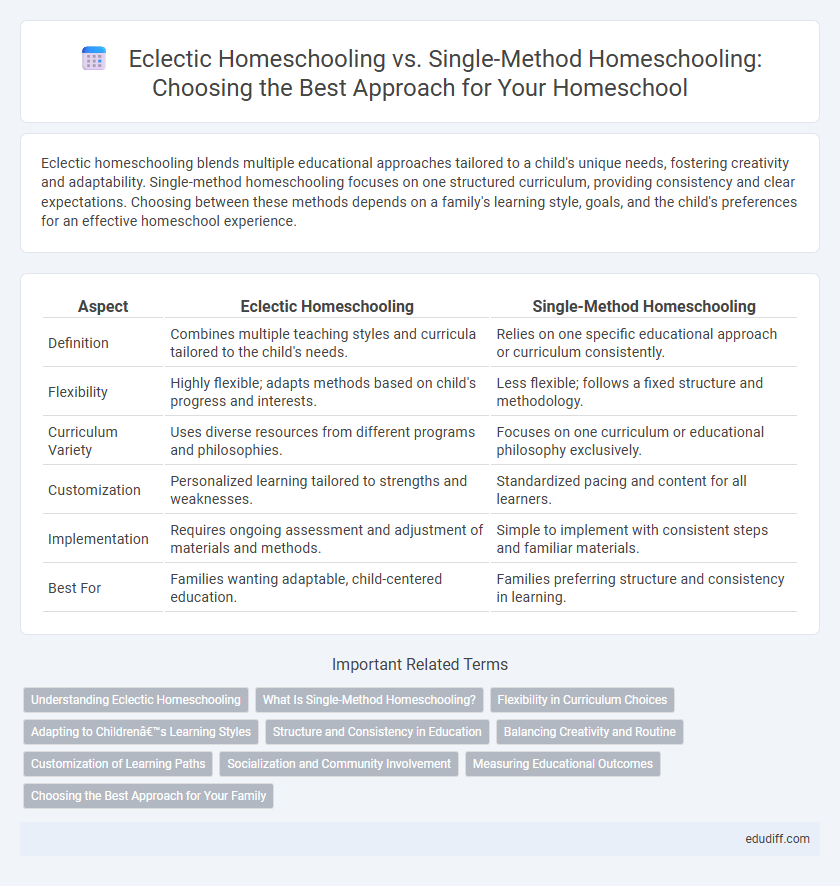Eclectic homeschooling blends multiple educational approaches tailored to a child's unique needs, fostering creativity and adaptability. Single-method homeschooling focuses on one structured curriculum, providing consistency and clear expectations. Choosing between these methods depends on a family's learning style, goals, and the child's preferences for an effective homeschool experience.
Table of Comparison
| Aspect | Eclectic Homeschooling | Single-Method Homeschooling |
|---|---|---|
| Definition | Combines multiple teaching styles and curricula tailored to the child's needs. | Relies on one specific educational approach or curriculum consistently. |
| Flexibility | Highly flexible; adapts methods based on child's progress and interests. | Less flexible; follows a fixed structure and methodology. |
| Curriculum Variety | Uses diverse resources from different programs and philosophies. | Focuses on one curriculum or educational philosophy exclusively. |
| Customization | Personalized learning tailored to strengths and weaknesses. | Standardized pacing and content for all learners. |
| Implementation | Requires ongoing assessment and adjustment of materials and methods. | Simple to implement with consistent steps and familiar materials. |
| Best For | Families wanting adaptable, child-centered education. | Families preferring structure and consistency in learning. |
Understanding Eclectic Homeschooling
Eclectic homeschooling combines multiple teaching methods tailored to a child's unique learning style, promoting flexibility and personalized education. Parents select resources from various curricula to create a diverse, adaptive learning environment that addresses strengths and challenges effectively. This approach contrasts with single-method homeschooling by offering a broader range of materials and instructional techniques, fostering engagement and comprehensive skill development.
What Is Single-Method Homeschooling?
Single-method homeschooling strictly follows one educational philosophy or curriculum, such as Classical, Montessori, or Charlotte Mason, providing a consistent and structured learning experience. This approach emphasizes mastery of specific pedagogical principles and materials, often aligning with a family's educational values or goals. By concentrating on a single methodology, parents can maintain clarity and continuity in lesson planning and assessment.
Flexibility in Curriculum Choices
Eclectic homeschooling offers unparalleled flexibility in curriculum choices by allowing parents to combine multiple educational philosophies and resources tailored to their child's unique learning style. Single-method homeschooling relies on a structured curriculum from a specific educational approach, limiting adaptability to individual needs. This flexibility in eclectic homeschooling supports a more personalized and dynamic educational experience, accommodating evolving interests and strengths.
Adapting to Children’s Learning Styles
Eclectic homeschooling allows parents to tailor curriculum and teaching methods to fit each child's unique learning style, enhancing engagement and comprehension. Single-method homeschooling relies on a consistent approach, which may not address individual learning preferences but provides structure and familiarity. Adapting to children's learning styles through eclectic homeschooling promotes flexibility and personalized education, fostering better academic outcomes.
Structure and Consistency in Education
Eclectic homeschooling offers flexible structure by combining diverse teaching methods tailored to a child's evolving learning style, whereas single-method homeschooling relies on consistent routines and a singular educational philosophy for predictability. Families choosing eclectic approaches adapt curriculum pacing and resources to meet individual student needs, fostering creativity but potentially challenging routine establishment. In contrast, single-method homeschooling emphasizes steady schedules and uniform content delivery, promoting reliable educational consistency and measurable progress.
Balancing Creativity and Routine
Eclectic homeschooling blends multiple teaching methods, fostering creativity by allowing parents to tailor lessons to their child's unique learning style while maintaining a flexible routine. Single-method homeschooling relies on a consistent, structured approach, promoting stability and clear expectations but may limit spontaneous creative exploration. Balancing creativity and routine in homeschooling involves integrating varied educational resources within a consistent schedule, enhancing engagement and academic progress.
Customization of Learning Paths
Eclectic homeschooling allows parents to tailor learning paths by blending multiple educational methods, fostering a highly personalized and flexible curriculum. Single-method homeschooling follows a consistent approach, often limiting adaptability to a child's evolving interests and strengths. Customization in eclectic homeschooling supports diverse learning styles, optimizing student engagement and academic growth.
Socialization and Community Involvement
Eclectic homeschooling offers diverse socialization opportunities by blending multiple curricula and community activities, fostering adaptability and broad peer interaction. In contrast, single-method homeschooling often centers on a structured approach with limited social settings, potentially narrowing social exposure but deepening connections within smaller communities. Families choosing eclectic homeschooling typically experience enhanced community involvement through varied group classes and extracurriculars, while single-method homeschoolers may engage more intensively in focused group activities aligned with their chosen curriculum.
Measuring Educational Outcomes
Eclectic homeschooling combines multiple teaching methods tailored to a child's unique learning style, often resulting in adaptable and well-rounded educational outcomes. Single-method homeschooling uses a consistent approach, making it easier to measure progress through standardized assessments but potentially limiting flexibility. Studies indicate that eclectic methods may enhance critical thinking and creativity, while single-method approaches typically yield more predictable academic performance metrics.
Choosing the Best Approach for Your Family
Eclectic homeschooling combines various teaching methods and curriculum sources, allowing parents to tailor education to their child's unique needs, strengths, and interests. Single-method homeschooling relies on one structured approach, such as classical, Montessori, or Charlotte Mason, offering consistency and focused pedagogy. Choosing the best approach depends on your family's educational goals, your child's learning style, and the flexibility you desire in your homeschooling routine.
Eclectic Homeschooling vs Single-Method Homeschooling Infographic

 edudiff.com
edudiff.com